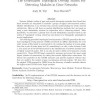Free Online Productivity Tools
i2Speak
i2Symbol
i2OCR
iTex2Img
iWeb2Print
iWeb2Shot
i2Type
iPdf2Split
iPdf2Merge
i2Bopomofo
i2Arabic
i2Style
i2Image
i2PDF
iLatex2Rtf
Sci2ools
BIOCOMP
2006
2006
The Generalized Topological Overlap Matrix for Detecting Modules in Gene Networks
Systems biologic studies of gene and protein interaction networks have found that these networks are comprised of `modules' (groups of tightly interconnected nodes). Module identification is an essential step towards understanding the whole network architecture. Here we will focus on module identification methods that are based on using a node dissimilarity measure in conjunction with a clustering method. More specifically, we introduce a general class of node dissimilarity measures based on the notion of `topological' overlap, which has been found to be biologically meaningful in several applications. The resulting generalized topological overlap measure (GTOM) generalizes the standard topological overlap measure (TOM) introduced by (2002). Specifically, the m-th order version of this family is constructed by (i) counting the number of m-step neighbors that a pair of nodes share and (ii) normalizing it to take a value between 0 and
BIOCOMP 2006 | BIOCOMP 2007 | Module Identification | Node Dissimilarity Measures | Topological Overlap Measure |
| Added | 30 Oct 2010 |
| Updated | 30 Oct 2010 |
| Type | Conference |
| Year | 2006 |
| Where | BIOCOMP |
| Authors | Andy M. Yip, Steve Horvath |
Comments (0)

